BSBFIM601 Manage Finances: Assessment Report, [Semester], [College]
VerifiedAdded on 2022/10/12
|32
|6069
|17
Report
AI Summary
This comprehensive report presents a detailed assessment of financial management principles, as applied to a business context. The report encompasses multiple assessment tasks, including knowledge questions on financial probity, accounting principles (accrual, cost, going concern, and revenue recognition), and key financial performance indicators (liquidity, solvency, profitability, and efficiency). It delves into relevant legislation such as the Australian Securities and Investments Commission Act 2001, the Corporations Act 2001, and the Competition and Consumer Act 2010. Furthermore, the assessment involves practical exercises like creating sales and profit budgets, GST cash flow budgets, and debtors aging summaries. The report also includes analysis of financial performance, variance analysis, and recommendations for financial viability and risk management. It explores relevant business obligations, including ABN, GST, PAYG, and superannuation. The report is a complete guide for financial management.
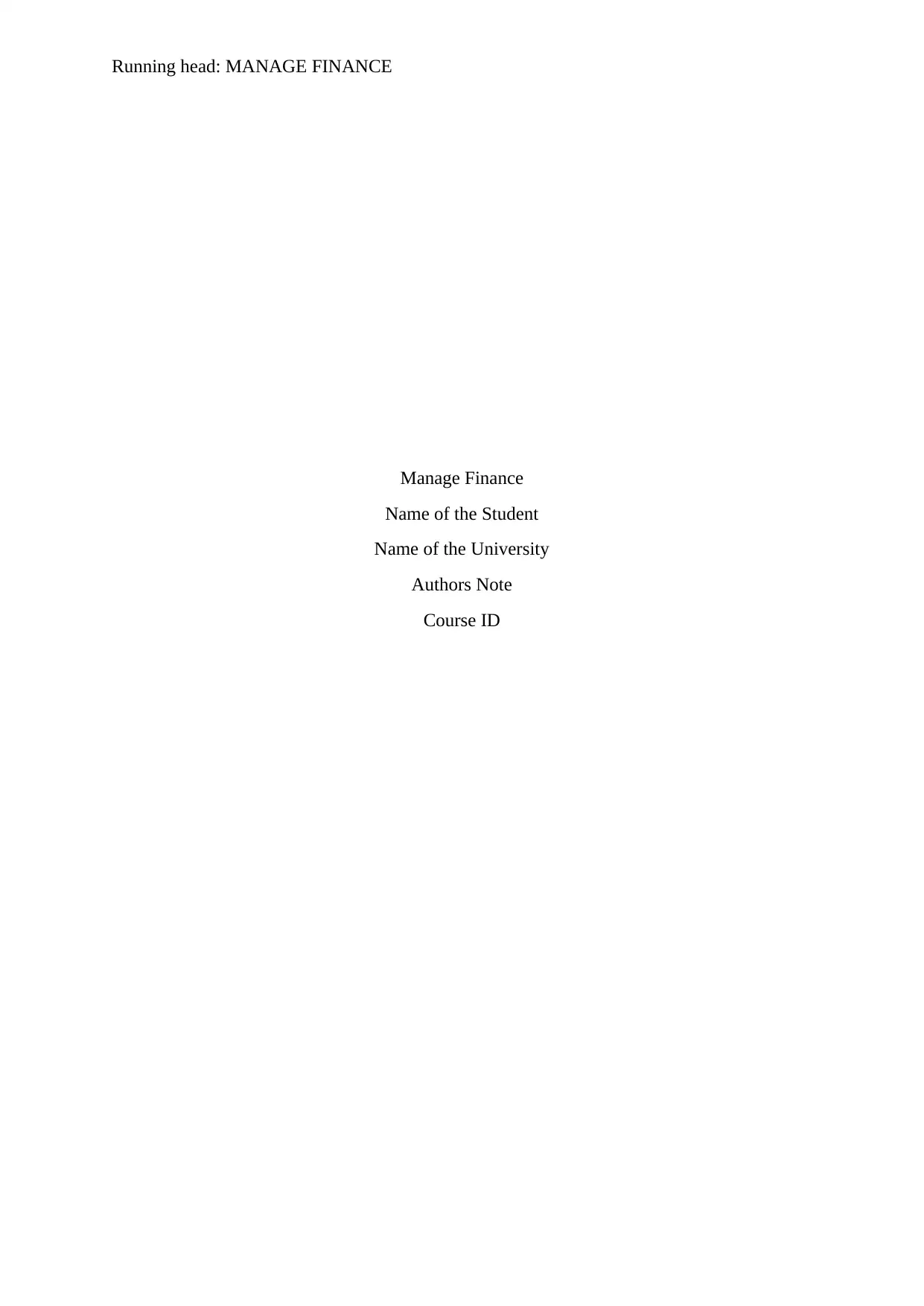
Running head: MANAGE FINANCE
Manage Finance
Name of the Student
Name of the University
Authors Note
Course ID
Manage Finance
Name of the Student
Name of the University
Authors Note
Course ID
Paraphrase This Document
Need a fresh take? Get an instant paraphrase of this document with our AI Paraphraser
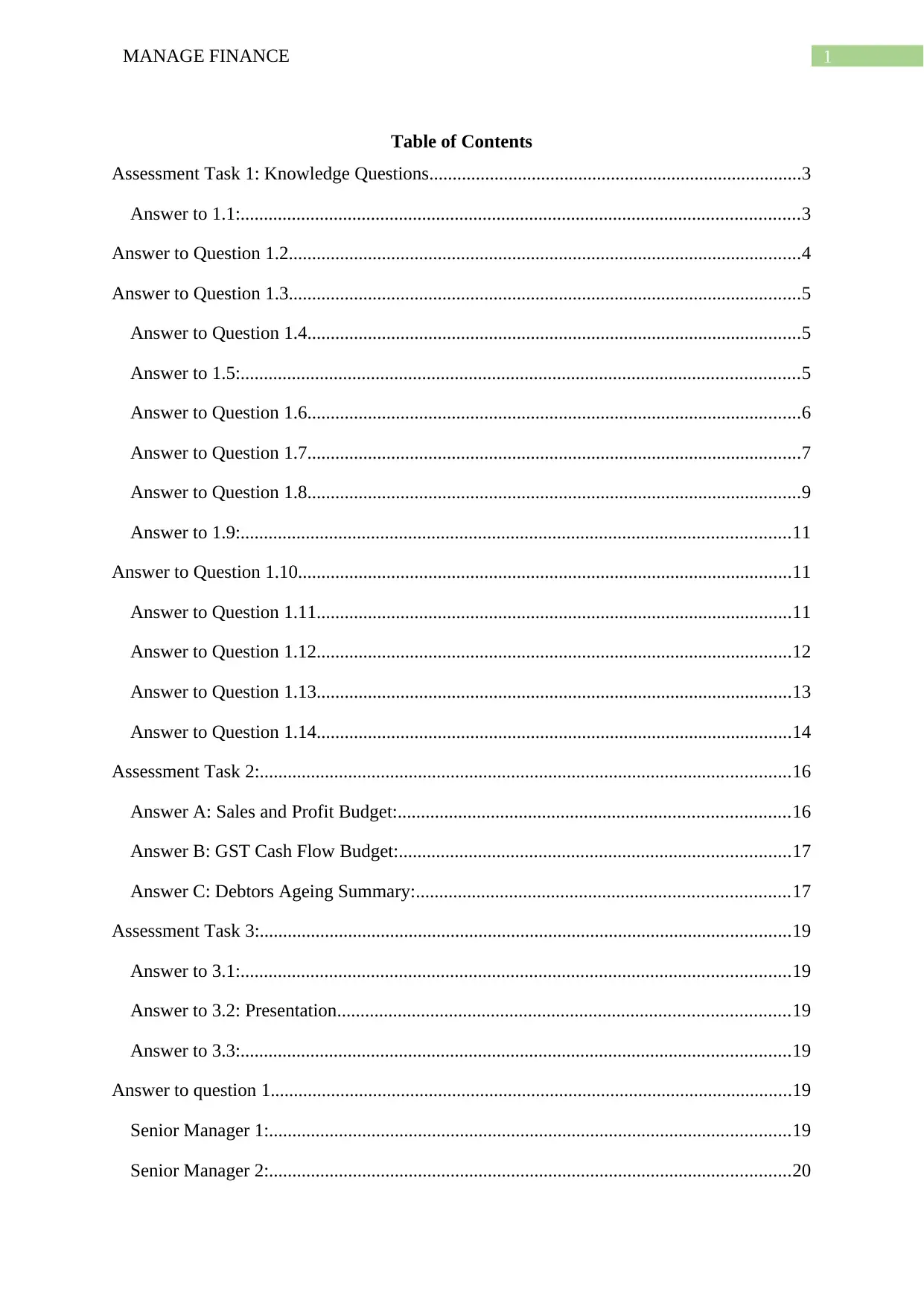
1MANAGE FINANCE
Table of Contents
Assessment Task 1: Knowledge Questions................................................................................3
Answer to 1.1:........................................................................................................................3
Answer to Question 1.2..............................................................................................................4
Answer to Question 1.3..............................................................................................................5
Answer to Question 1.4..........................................................................................................5
Answer to 1.5:........................................................................................................................5
Answer to Question 1.6..........................................................................................................6
Answer to Question 1.7..........................................................................................................7
Answer to Question 1.8..........................................................................................................9
Answer to 1.9:......................................................................................................................11
Answer to Question 1.10..........................................................................................................11
Answer to Question 1.11......................................................................................................11
Answer to Question 1.12......................................................................................................12
Answer to Question 1.13......................................................................................................13
Answer to Question 1.14......................................................................................................14
Assessment Task 2:..................................................................................................................16
Answer A: Sales and Profit Budget:....................................................................................16
Answer B: GST Cash Flow Budget:....................................................................................17
Answer C: Debtors Ageing Summary:................................................................................17
Assessment Task 3:..................................................................................................................19
Answer to 3.1:......................................................................................................................19
Answer to 3.2: Presentation.................................................................................................19
Answer to 3.3:......................................................................................................................19
Answer to question 1................................................................................................................19
Senior Manager 1:................................................................................................................19
Senior Manager 2:................................................................................................................20
Table of Contents
Assessment Task 1: Knowledge Questions................................................................................3
Answer to 1.1:........................................................................................................................3
Answer to Question 1.2..............................................................................................................4
Answer to Question 1.3..............................................................................................................5
Answer to Question 1.4..........................................................................................................5
Answer to 1.5:........................................................................................................................5
Answer to Question 1.6..........................................................................................................6
Answer to Question 1.7..........................................................................................................7
Answer to Question 1.8..........................................................................................................9
Answer to 1.9:......................................................................................................................11
Answer to Question 1.10..........................................................................................................11
Answer to Question 1.11......................................................................................................11
Answer to Question 1.12......................................................................................................12
Answer to Question 1.13......................................................................................................13
Answer to Question 1.14......................................................................................................14
Assessment Task 2:..................................................................................................................16
Answer A: Sales and Profit Budget:....................................................................................16
Answer B: GST Cash Flow Budget:....................................................................................17
Answer C: Debtors Ageing Summary:................................................................................17
Assessment Task 3:..................................................................................................................19
Answer to 3.1:......................................................................................................................19
Answer to 3.2: Presentation.................................................................................................19
Answer to 3.3:......................................................................................................................19
Answer to question 1................................................................................................................19
Senior Manager 1:................................................................................................................19
Senior Manager 2:................................................................................................................20
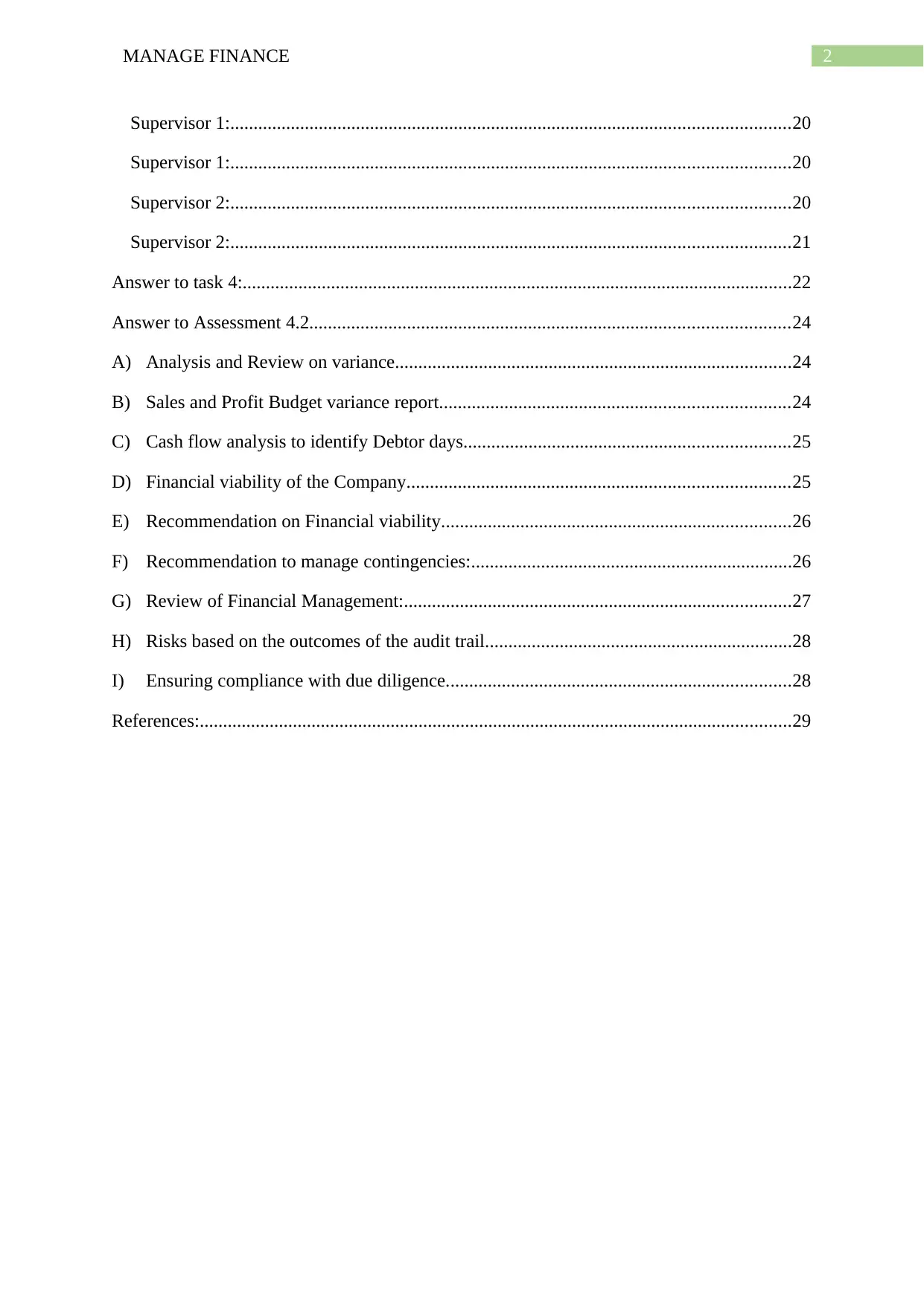
2MANAGE FINANCE
Supervisor 1:........................................................................................................................20
Supervisor 1:........................................................................................................................20
Supervisor 2:........................................................................................................................20
Supervisor 2:........................................................................................................................21
Answer to task 4:......................................................................................................................22
Answer to Assessment 4.2.......................................................................................................24
A) Analysis and Review on variance.....................................................................................24
B) Sales and Profit Budget variance report...........................................................................24
C) Cash flow analysis to identify Debtor days......................................................................25
D) Financial viability of the Company..................................................................................25
E) Recommendation on Financial viability...........................................................................26
F) Recommendation to manage contingencies:.....................................................................26
G) Review of Financial Management:...................................................................................27
H) Risks based on the outcomes of the audit trail..................................................................28
I) Ensuring compliance with due diligence..........................................................................28
References:...............................................................................................................................29
Supervisor 1:........................................................................................................................20
Supervisor 1:........................................................................................................................20
Supervisor 2:........................................................................................................................20
Supervisor 2:........................................................................................................................21
Answer to task 4:......................................................................................................................22
Answer to Assessment 4.2.......................................................................................................24
A) Analysis and Review on variance.....................................................................................24
B) Sales and Profit Budget variance report...........................................................................24
C) Cash flow analysis to identify Debtor days......................................................................25
D) Financial viability of the Company..................................................................................25
E) Recommendation on Financial viability...........................................................................26
F) Recommendation to manage contingencies:.....................................................................26
G) Review of Financial Management:...................................................................................27
H) Risks based on the outcomes of the audit trail..................................................................28
I) Ensuring compliance with due diligence..........................................................................28
References:...............................................................................................................................29
⊘ This is a preview!⊘
Do you want full access?
Subscribe today to unlock all pages.

Trusted by 1+ million students worldwide
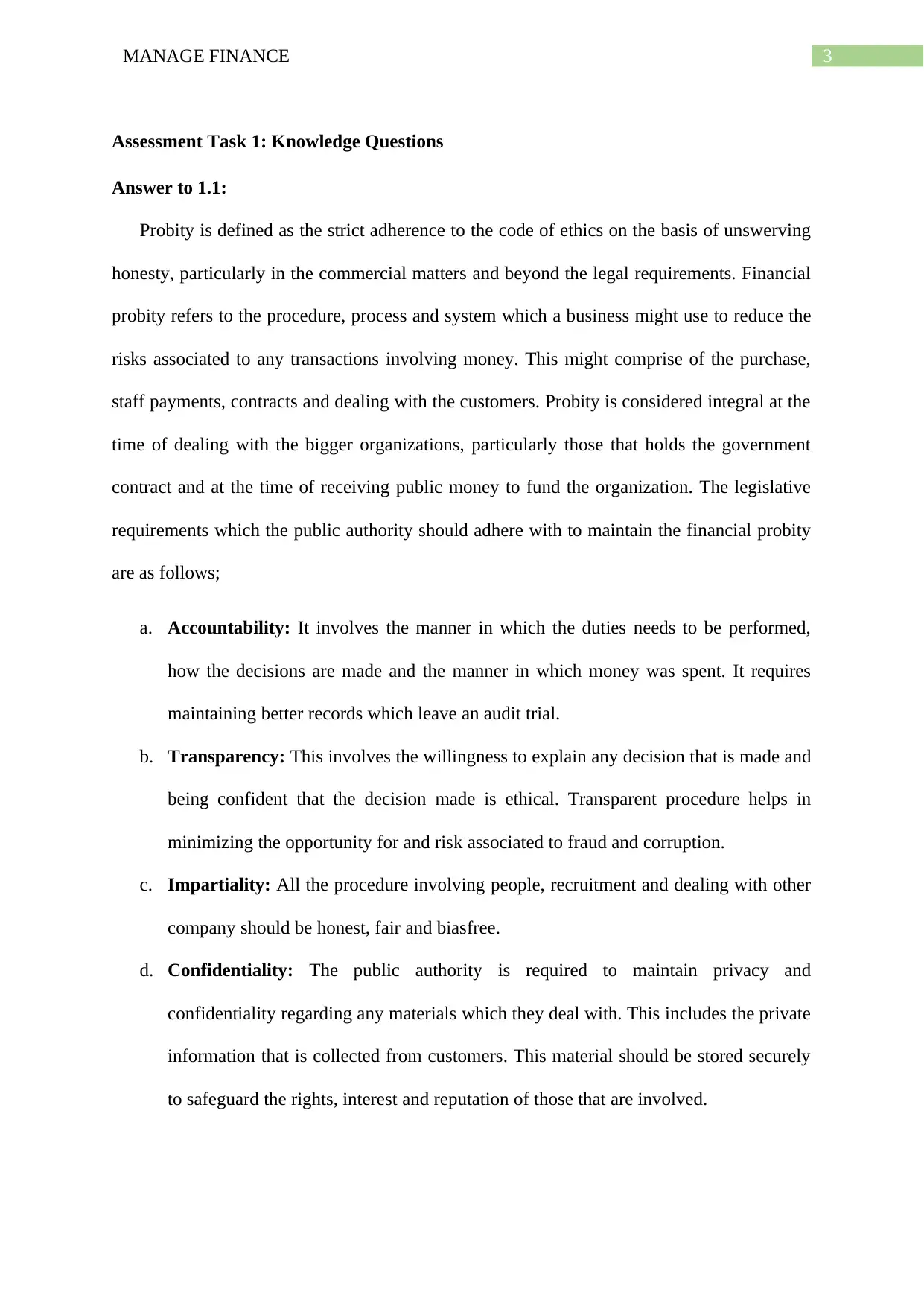
3MANAGE FINANCE
Assessment Task 1: Knowledge Questions
Answer to 1.1:
Probity is defined as the strict adherence to the code of ethics on the basis of unswerving
honesty, particularly in the commercial matters and beyond the legal requirements. Financial
probity refers to the procedure, process and system which a business might use to reduce the
risks associated to any transactions involving money. This might comprise of the purchase,
staff payments, contracts and dealing with the customers. Probity is considered integral at the
time of dealing with the bigger organizations, particularly those that holds the government
contract and at the time of receiving public money to fund the organization. The legislative
requirements which the public authority should adhere with to maintain the financial probity
are as follows;
a. Accountability: It involves the manner in which the duties needs to be performed,
how the decisions are made and the manner in which money was spent. It requires
maintaining better records which leave an audit trial.
b. Transparency: This involves the willingness to explain any decision that is made and
being confident that the decision made is ethical. Transparent procedure helps in
minimizing the opportunity for and risk associated to fraud and corruption.
c. Impartiality: All the procedure involving people, recruitment and dealing with other
company should be honest, fair and biasfree.
d. Confidentiality: The public authority is required to maintain privacy and
confidentiality regarding any materials which they deal with. This includes the private
information that is collected from customers. This material should be stored securely
to safeguard the rights, interest and reputation of those that are involved.
Assessment Task 1: Knowledge Questions
Answer to 1.1:
Probity is defined as the strict adherence to the code of ethics on the basis of unswerving
honesty, particularly in the commercial matters and beyond the legal requirements. Financial
probity refers to the procedure, process and system which a business might use to reduce the
risks associated to any transactions involving money. This might comprise of the purchase,
staff payments, contracts and dealing with the customers. Probity is considered integral at the
time of dealing with the bigger organizations, particularly those that holds the government
contract and at the time of receiving public money to fund the organization. The legislative
requirements which the public authority should adhere with to maintain the financial probity
are as follows;
a. Accountability: It involves the manner in which the duties needs to be performed,
how the decisions are made and the manner in which money was spent. It requires
maintaining better records which leave an audit trial.
b. Transparency: This involves the willingness to explain any decision that is made and
being confident that the decision made is ethical. Transparent procedure helps in
minimizing the opportunity for and risk associated to fraud and corruption.
c. Impartiality: All the procedure involving people, recruitment and dealing with other
company should be honest, fair and biasfree.
d. Confidentiality: The public authority is required to maintain privacy and
confidentiality regarding any materials which they deal with. This includes the private
information that is collected from customers. This material should be stored securely
to safeguard the rights, interest and reputation of those that are involved.
Paraphrase This Document
Need a fresh take? Get an instant paraphrase of this document with our AI Paraphraser
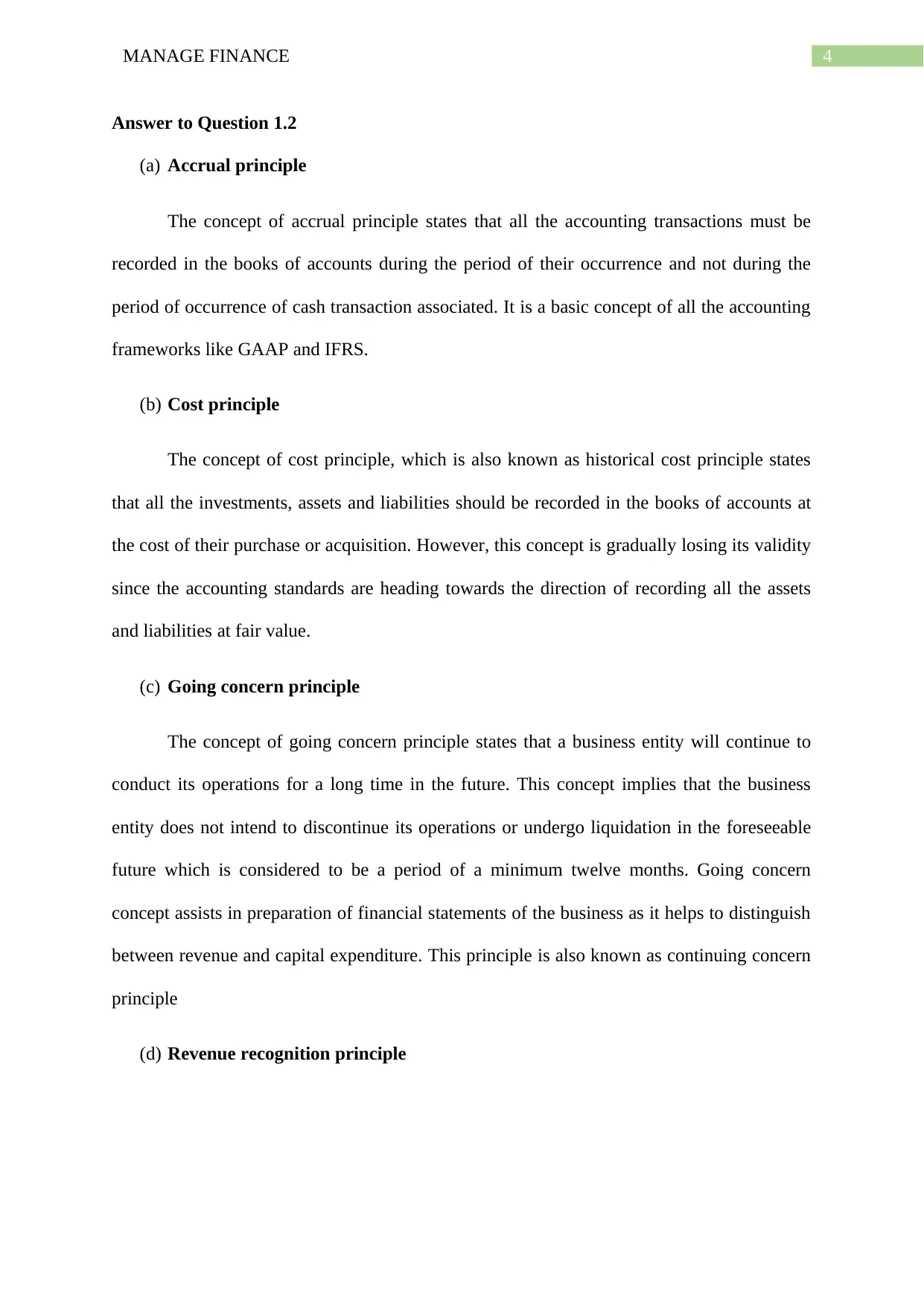
4MANAGE FINANCE
Answer to Question 1.2
(a) Accrual principle
The concept of accrual principle states that all the accounting transactions must be
recorded in the books of accounts during the period of their occurrence and not during the
period of occurrence of cash transaction associated. It is a basic concept of all the accounting
frameworks like GAAP and IFRS.
(b) Cost principle
The concept of cost principle, which is also known as historical cost principle states
that all the investments, assets and liabilities should be recorded in the books of accounts at
the cost of their purchase or acquisition. However, this concept is gradually losing its validity
since the accounting standards are heading towards the direction of recording all the assets
and liabilities at fair value.
(c) Going concern principle
The concept of going concern principle states that a business entity will continue to
conduct its operations for a long time in the future. This concept implies that the business
entity does not intend to discontinue its operations or undergo liquidation in the foreseeable
future which is considered to be a period of a minimum twelve months. Going concern
concept assists in preparation of financial statements of the business as it helps to distinguish
between revenue and capital expenditure. This principle is also known as continuing concern
principle
(d) Revenue recognition principle
Answer to Question 1.2
(a) Accrual principle
The concept of accrual principle states that all the accounting transactions must be
recorded in the books of accounts during the period of their occurrence and not during the
period of occurrence of cash transaction associated. It is a basic concept of all the accounting
frameworks like GAAP and IFRS.
(b) Cost principle
The concept of cost principle, which is also known as historical cost principle states
that all the investments, assets and liabilities should be recorded in the books of accounts at
the cost of their purchase or acquisition. However, this concept is gradually losing its validity
since the accounting standards are heading towards the direction of recording all the assets
and liabilities at fair value.
(c) Going concern principle
The concept of going concern principle states that a business entity will continue to
conduct its operations for a long time in the future. This concept implies that the business
entity does not intend to discontinue its operations or undergo liquidation in the foreseeable
future which is considered to be a period of a minimum twelve months. Going concern
concept assists in preparation of financial statements of the business as it helps to distinguish
between revenue and capital expenditure. This principle is also known as continuing concern
principle
(d) Revenue recognition principle
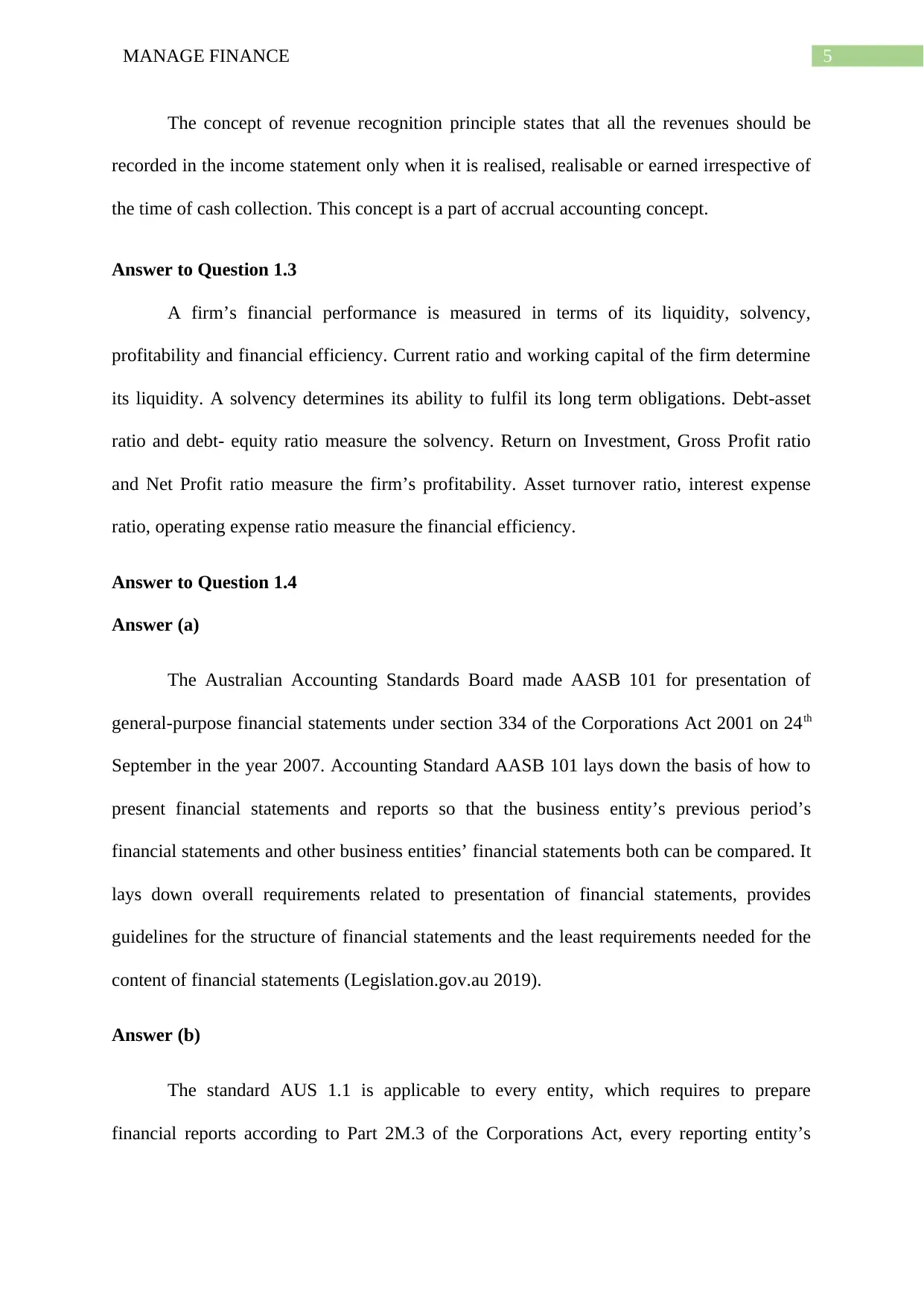
5MANAGE FINANCE
The concept of revenue recognition principle states that all the revenues should be
recorded in the income statement only when it is realised, realisable or earned irrespective of
the time of cash collection. This concept is a part of accrual accounting concept.
Answer to Question 1.3
A firm’s financial performance is measured in terms of its liquidity, solvency,
profitability and financial efficiency. Current ratio and working capital of the firm determine
its liquidity. A solvency determines its ability to fulfil its long term obligations. Debt-asset
ratio and debt- equity ratio measure the solvency. Return on Investment, Gross Profit ratio
and Net Profit ratio measure the firm’s profitability. Asset turnover ratio, interest expense
ratio, operating expense ratio measure the financial efficiency.
Answer to Question 1.4
Answer (a)
The Australian Accounting Standards Board made AASB 101 for presentation of
general-purpose financial statements under section 334 of the Corporations Act 2001 on 24th
September in the year 2007. Accounting Standard AASB 101 lays down the basis of how to
present financial statements and reports so that the business entity’s previous period’s
financial statements and other business entities’ financial statements both can be compared. It
lays down overall requirements related to presentation of financial statements, provides
guidelines for the structure of financial statements and the least requirements needed for the
content of financial statements (Legislation.gov.au 2019).
Answer (b)
The standard AUS 1.1 is applicable to every entity, which requires to prepare
financial reports according to Part 2M.3 of the Corporations Act, every reporting entity’s
The concept of revenue recognition principle states that all the revenues should be
recorded in the income statement only when it is realised, realisable or earned irrespective of
the time of cash collection. This concept is a part of accrual accounting concept.
Answer to Question 1.3
A firm’s financial performance is measured in terms of its liquidity, solvency,
profitability and financial efficiency. Current ratio and working capital of the firm determine
its liquidity. A solvency determines its ability to fulfil its long term obligations. Debt-asset
ratio and debt- equity ratio measure the solvency. Return on Investment, Gross Profit ratio
and Net Profit ratio measure the firm’s profitability. Asset turnover ratio, interest expense
ratio, operating expense ratio measure the financial efficiency.
Answer to Question 1.4
Answer (a)
The Australian Accounting Standards Board made AASB 101 for presentation of
general-purpose financial statements under section 334 of the Corporations Act 2001 on 24th
September in the year 2007. Accounting Standard AASB 101 lays down the basis of how to
present financial statements and reports so that the business entity’s previous period’s
financial statements and other business entities’ financial statements both can be compared. It
lays down overall requirements related to presentation of financial statements, provides
guidelines for the structure of financial statements and the least requirements needed for the
content of financial statements (Legislation.gov.au 2019).
Answer (b)
The standard AUS 1.1 is applicable to every entity, which requires to prepare
financial reports according to Part 2M.3 of the Corporations Act, every reporting entity’s
⊘ This is a preview!⊘
Do you want full access?
Subscribe today to unlock all pages.

Trusted by 1+ million students worldwide
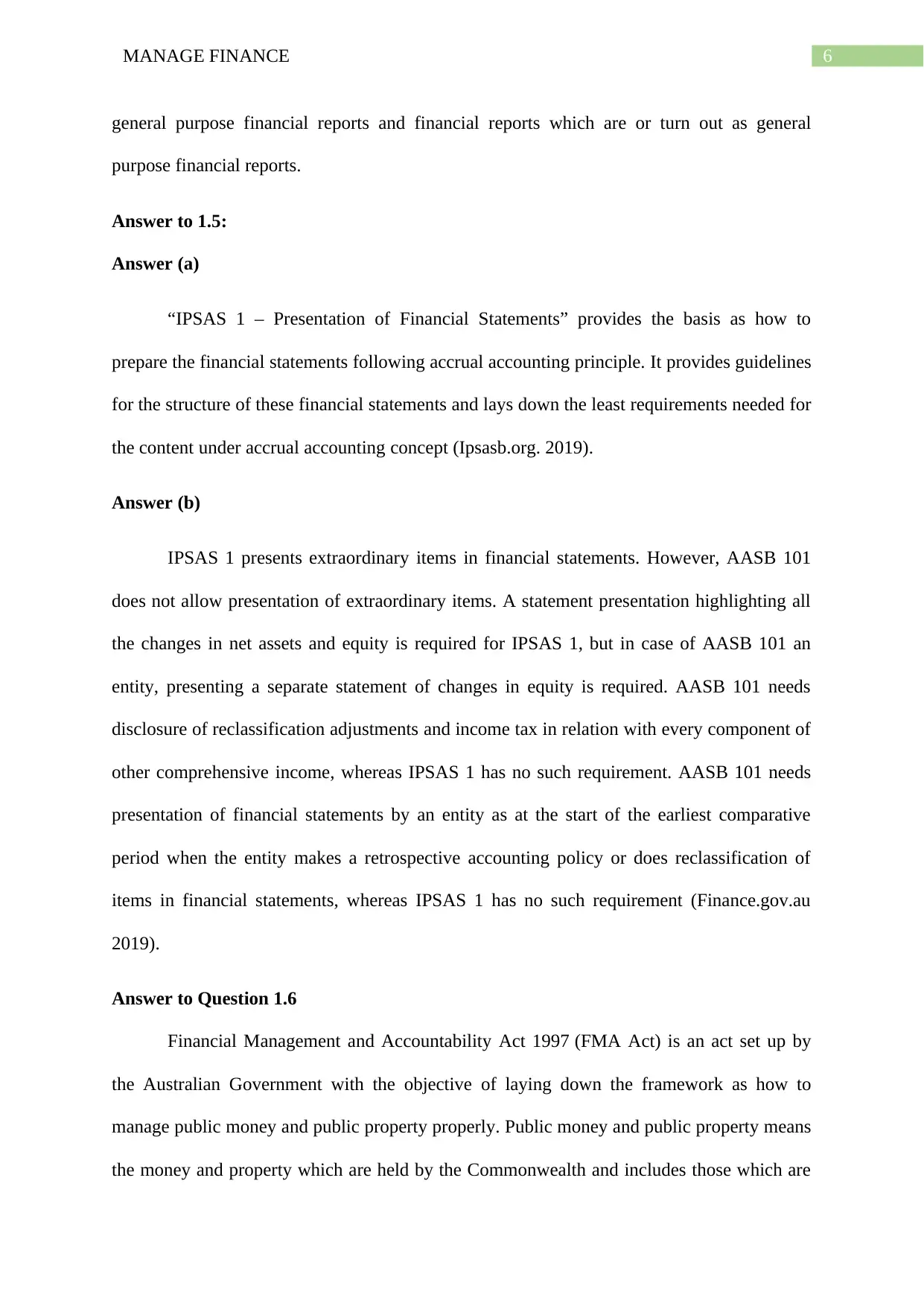
6MANAGE FINANCE
general purpose financial reports and financial reports which are or turn out as general
purpose financial reports.
Answer to 1.5:
Answer (a)
“IPSAS 1 – Presentation of Financial Statements” provides the basis as how to
prepare the financial statements following accrual accounting principle. It provides guidelines
for the structure of these financial statements and lays down the least requirements needed for
the content under accrual accounting concept (Ipsasb.org. 2019).
Answer (b)
IPSAS 1 presents extraordinary items in financial statements. However, AASB 101
does not allow presentation of extraordinary items. A statement presentation highlighting all
the changes in net assets and equity is required for IPSAS 1, but in case of AASB 101 an
entity, presenting a separate statement of changes in equity is required. AASB 101 needs
disclosure of reclassification adjustments and income tax in relation with every component of
other comprehensive income, whereas IPSAS 1 has no such requirement. AASB 101 needs
presentation of financial statements by an entity as at the start of the earliest comparative
period when the entity makes a retrospective accounting policy or does reclassification of
items in financial statements, whereas IPSAS 1 has no such requirement (Finance.gov.au
2019).
Answer to Question 1.6
Financial Management and Accountability Act 1997 (FMA Act) is an act set up by
the Australian Government with the objective of laying down the framework as how to
manage public money and public property properly. Public money and public property means
the money and property which are held by the Commonwealth and includes those which are
general purpose financial reports and financial reports which are or turn out as general
purpose financial reports.
Answer to 1.5:
Answer (a)
“IPSAS 1 – Presentation of Financial Statements” provides the basis as how to
prepare the financial statements following accrual accounting principle. It provides guidelines
for the structure of these financial statements and lays down the least requirements needed for
the content under accrual accounting concept (Ipsasb.org. 2019).
Answer (b)
IPSAS 1 presents extraordinary items in financial statements. However, AASB 101
does not allow presentation of extraordinary items. A statement presentation highlighting all
the changes in net assets and equity is required for IPSAS 1, but in case of AASB 101 an
entity, presenting a separate statement of changes in equity is required. AASB 101 needs
disclosure of reclassification adjustments and income tax in relation with every component of
other comprehensive income, whereas IPSAS 1 has no such requirement. AASB 101 needs
presentation of financial statements by an entity as at the start of the earliest comparative
period when the entity makes a retrospective accounting policy or does reclassification of
items in financial statements, whereas IPSAS 1 has no such requirement (Finance.gov.au
2019).
Answer to Question 1.6
Financial Management and Accountability Act 1997 (FMA Act) is an act set up by
the Australian Government with the objective of laying down the framework as how to
manage public money and public property properly. Public money and public property means
the money and property which are held by the Commonwealth and includes those which are
Paraphrase This Document
Need a fresh take? Get an instant paraphrase of this document with our AI Paraphraser
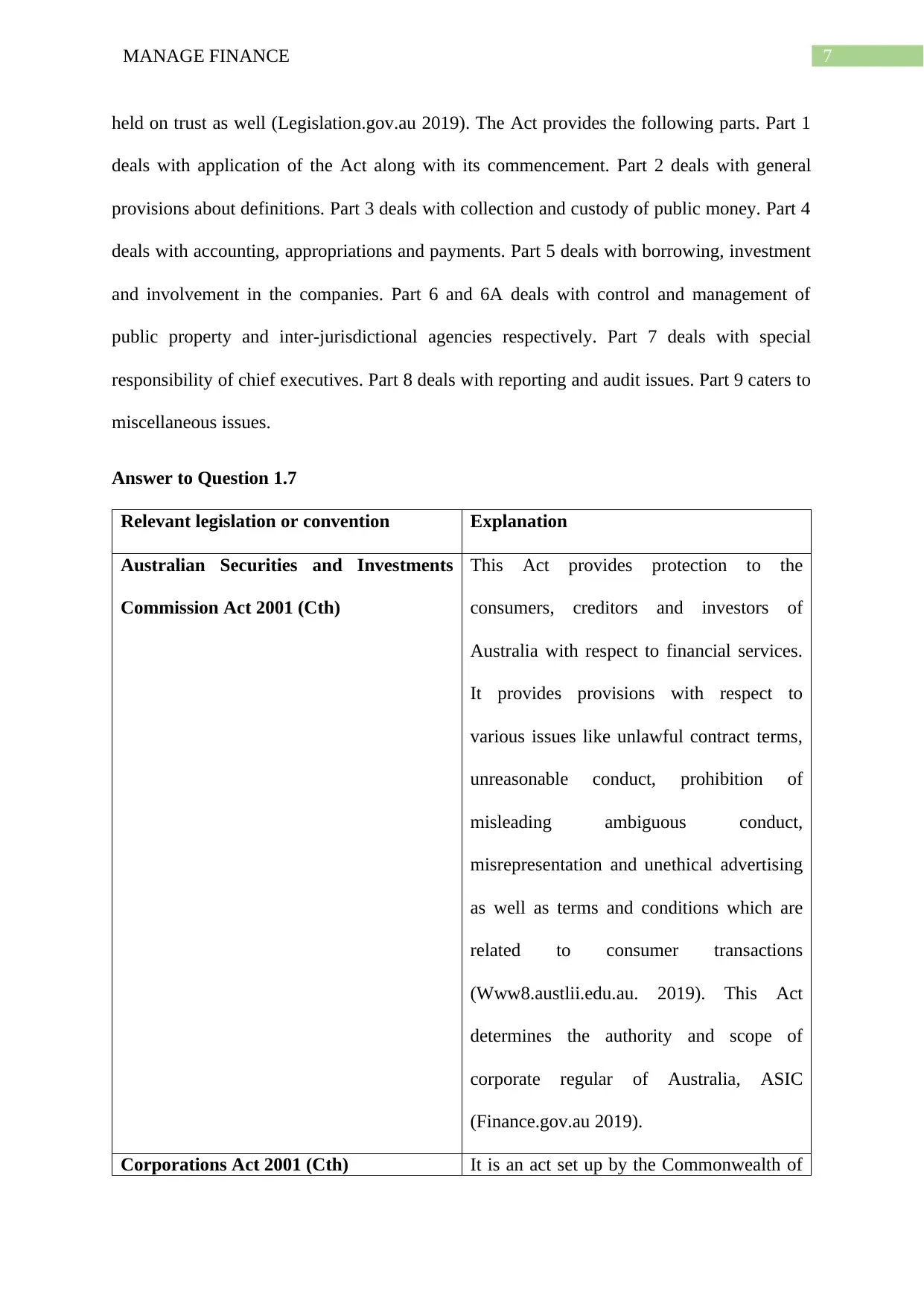
7MANAGE FINANCE
held on trust as well (Legislation.gov.au 2019). The Act provides the following parts. Part 1
deals with application of the Act along with its commencement. Part 2 deals with general
provisions about definitions. Part 3 deals with collection and custody of public money. Part 4
deals with accounting, appropriations and payments. Part 5 deals with borrowing, investment
and involvement in the companies. Part 6 and 6A deals with control and management of
public property and inter-jurisdictional agencies respectively. Part 7 deals with special
responsibility of chief executives. Part 8 deals with reporting and audit issues. Part 9 caters to
miscellaneous issues.
Answer to Question 1.7
Relevant legislation or convention Explanation
Australian Securities and Investments
Commission Act 2001 (Cth)
This Act provides protection to the
consumers, creditors and investors of
Australia with respect to financial services.
It provides provisions with respect to
various issues like unlawful contract terms,
unreasonable conduct, prohibition of
misleading ambiguous conduct,
misrepresentation and unethical advertising
as well as terms and conditions which are
related to consumer transactions
(Www8.austlii.edu.au. 2019). This Act
determines the authority and scope of
corporate regular of Australia, ASIC
(Finance.gov.au 2019).
Corporations Act 2001 (Cth) It is an act set up by the Commonwealth of
held on trust as well (Legislation.gov.au 2019). The Act provides the following parts. Part 1
deals with application of the Act along with its commencement. Part 2 deals with general
provisions about definitions. Part 3 deals with collection and custody of public money. Part 4
deals with accounting, appropriations and payments. Part 5 deals with borrowing, investment
and involvement in the companies. Part 6 and 6A deals with control and management of
public property and inter-jurisdictional agencies respectively. Part 7 deals with special
responsibility of chief executives. Part 8 deals with reporting and audit issues. Part 9 caters to
miscellaneous issues.
Answer to Question 1.7
Relevant legislation or convention Explanation
Australian Securities and Investments
Commission Act 2001 (Cth)
This Act provides protection to the
consumers, creditors and investors of
Australia with respect to financial services.
It provides provisions with respect to
various issues like unlawful contract terms,
unreasonable conduct, prohibition of
misleading ambiguous conduct,
misrepresentation and unethical advertising
as well as terms and conditions which are
related to consumer transactions
(Www8.austlii.edu.au. 2019). This Act
determines the authority and scope of
corporate regular of Australia, ASIC
(Finance.gov.au 2019).
Corporations Act 2001 (Cth) It is an act set up by the Commonwealth of
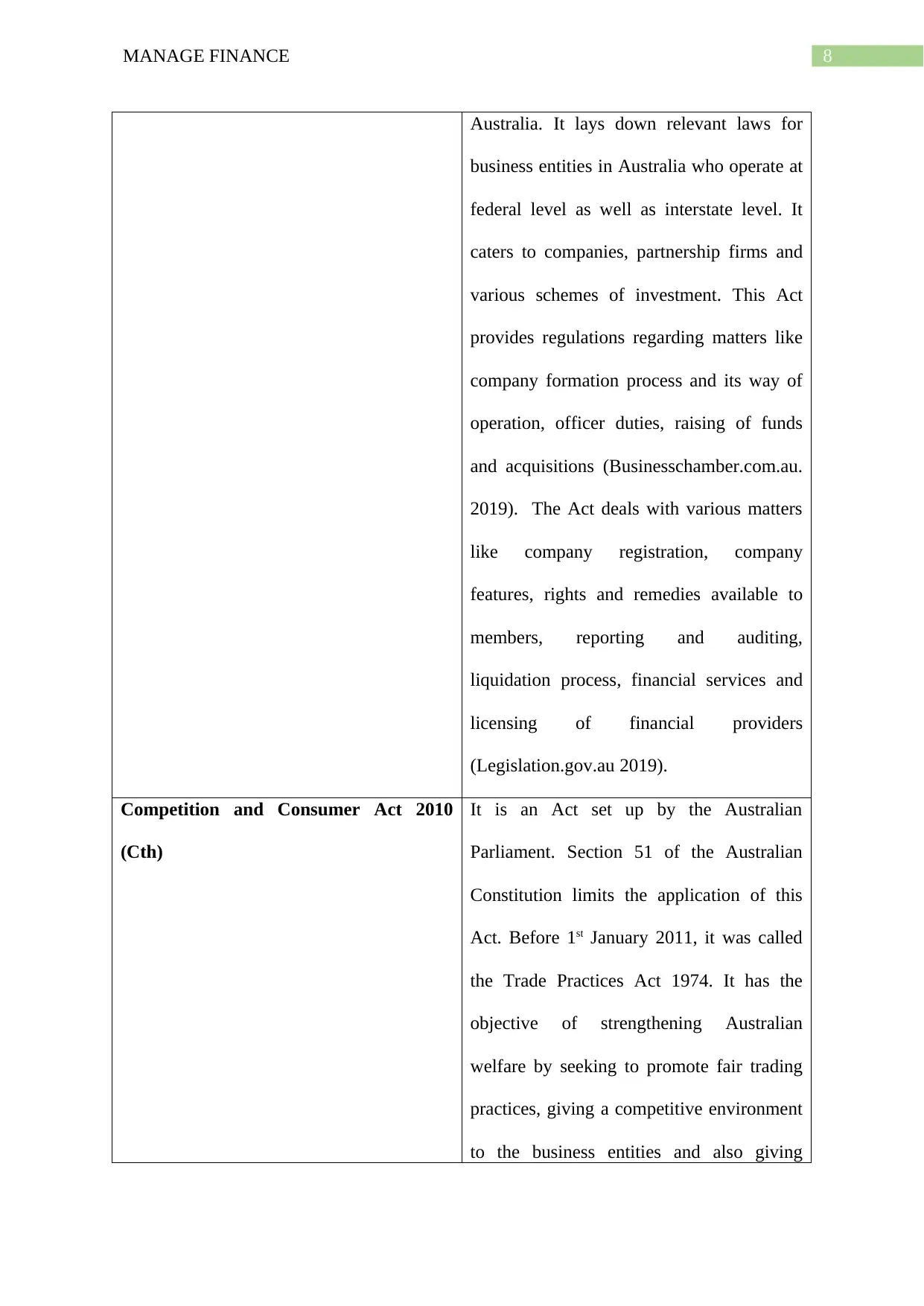
8MANAGE FINANCE
Australia. It lays down relevant laws for
business entities in Australia who operate at
federal level as well as interstate level. It
caters to companies, partnership firms and
various schemes of investment. This Act
provides regulations regarding matters like
company formation process and its way of
operation, officer duties, raising of funds
and acquisitions (Businesschamber.com.au.
2019). The Act deals with various matters
like company registration, company
features, rights and remedies available to
members, reporting and auditing,
liquidation process, financial services and
licensing of financial providers
(Legislation.gov.au 2019).
Competition and Consumer Act 2010
(Cth)
It is an Act set up by the Australian
Parliament. Section 51 of the Australian
Constitution limits the application of this
Act. Before 1st January 2011, it was called
the Trade Practices Act 1974. It has the
objective of strengthening Australian
welfare by seeking to promote fair trading
practices, giving a competitive environment
to the business entities and also giving
Australia. It lays down relevant laws for
business entities in Australia who operate at
federal level as well as interstate level. It
caters to companies, partnership firms and
various schemes of investment. This Act
provides regulations regarding matters like
company formation process and its way of
operation, officer duties, raising of funds
and acquisitions (Businesschamber.com.au.
2019). The Act deals with various matters
like company registration, company
features, rights and remedies available to
members, reporting and auditing,
liquidation process, financial services and
licensing of financial providers
(Legislation.gov.au 2019).
Competition and Consumer Act 2010
(Cth)
It is an Act set up by the Australian
Parliament. Section 51 of the Australian
Constitution limits the application of this
Act. Before 1st January 2011, it was called
the Trade Practices Act 1974. It has the
objective of strengthening Australian
welfare by seeking to promote fair trading
practices, giving a competitive environment
to the business entities and also giving
⊘ This is a preview!⊘
Do you want full access?
Subscribe today to unlock all pages.

Trusted by 1+ million students worldwide
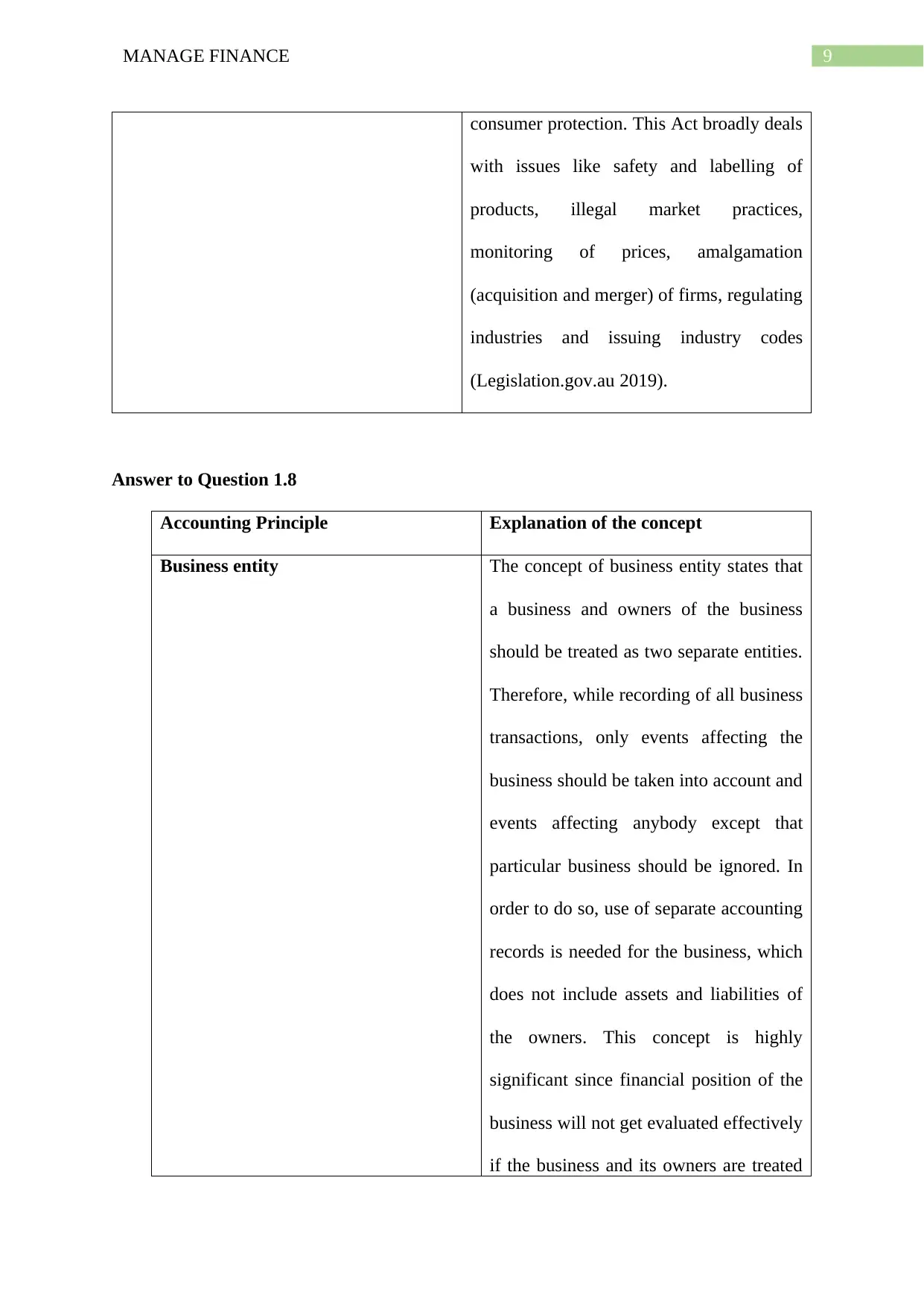
9MANAGE FINANCE
consumer protection. This Act broadly deals
with issues like safety and labelling of
products, illegal market practices,
monitoring of prices, amalgamation
(acquisition and merger) of firms, regulating
industries and issuing industry codes
(Legislation.gov.au 2019).
Answer to Question 1.8
Accounting Principle Explanation of the concept
Business entity The concept of business entity states that
a business and owners of the business
should be treated as two separate entities.
Therefore, while recording of all business
transactions, only events affecting the
business should be taken into account and
events affecting anybody except that
particular business should be ignored. In
order to do so, use of separate accounting
records is needed for the business, which
does not include assets and liabilities of
the owners. This concept is highly
significant since financial position of the
business will not get evaluated effectively
if the business and its owners are treated
consumer protection. This Act broadly deals
with issues like safety and labelling of
products, illegal market practices,
monitoring of prices, amalgamation
(acquisition and merger) of firms, regulating
industries and issuing industry codes
(Legislation.gov.au 2019).
Answer to Question 1.8
Accounting Principle Explanation of the concept
Business entity The concept of business entity states that
a business and owners of the business
should be treated as two separate entities.
Therefore, while recording of all business
transactions, only events affecting the
business should be taken into account and
events affecting anybody except that
particular business should be ignored. In
order to do so, use of separate accounting
records is needed for the business, which
does not include assets and liabilities of
the owners. This concept is highly
significant since financial position of the
business will not get evaluated effectively
if the business and its owners are treated
Paraphrase This Document
Need a fresh take? Get an instant paraphrase of this document with our AI Paraphraser
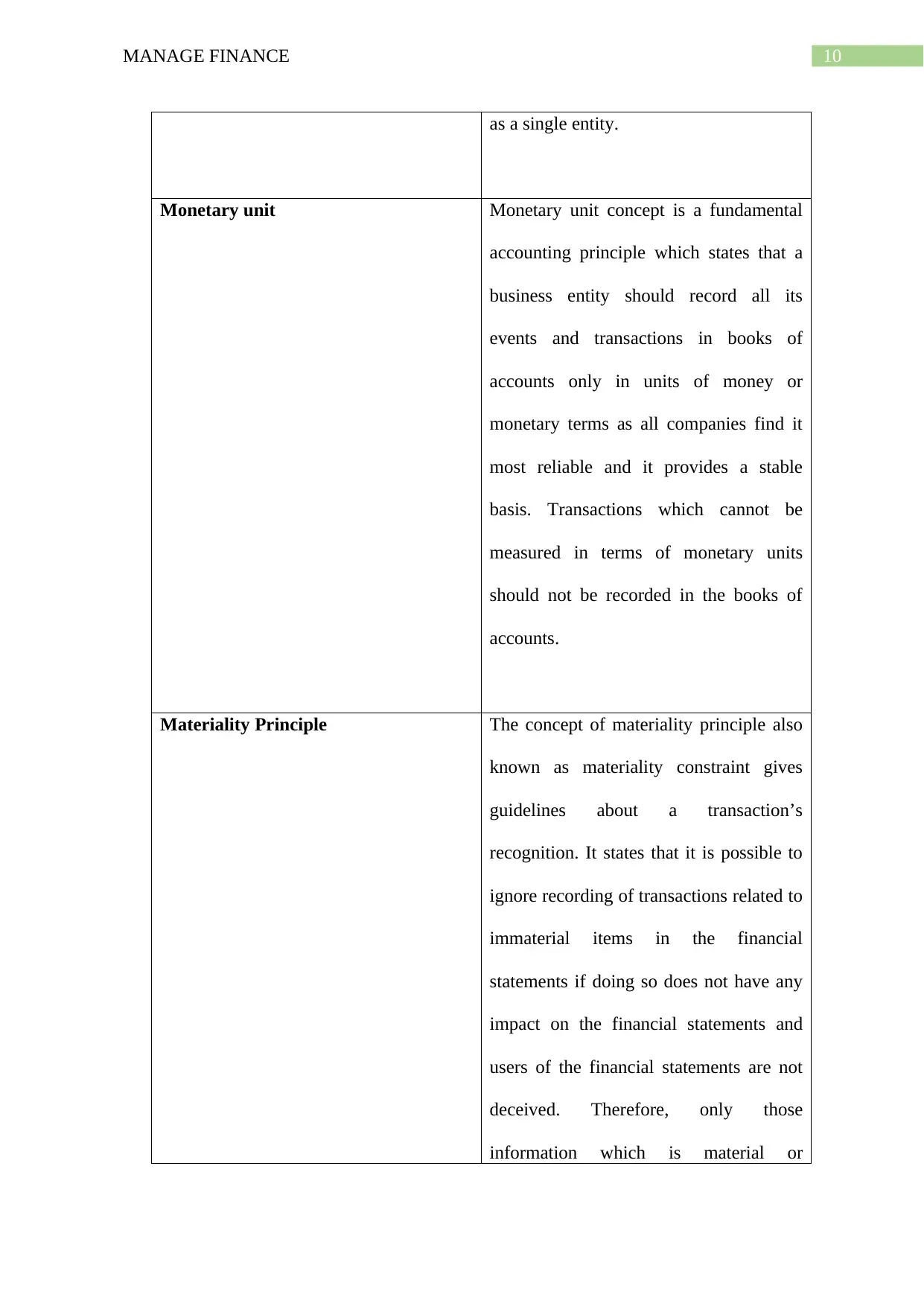
10MANAGE FINANCE
as a single entity.
Monetary unit Monetary unit concept is a fundamental
accounting principle which states that a
business entity should record all its
events and transactions in books of
accounts only in units of money or
monetary terms as all companies find it
most reliable and it provides a stable
basis. Transactions which cannot be
measured in terms of monetary units
should not be recorded in the books of
accounts.
Materiality Principle The concept of materiality principle also
known as materiality constraint gives
guidelines about a transaction’s
recognition. It states that it is possible to
ignore recording of transactions related to
immaterial items in the financial
statements if doing so does not have any
impact on the financial statements and
users of the financial statements are not
deceived. Therefore, only those
information which is material or
as a single entity.
Monetary unit Monetary unit concept is a fundamental
accounting principle which states that a
business entity should record all its
events and transactions in books of
accounts only in units of money or
monetary terms as all companies find it
most reliable and it provides a stable
basis. Transactions which cannot be
measured in terms of monetary units
should not be recorded in the books of
accounts.
Materiality Principle The concept of materiality principle also
known as materiality constraint gives
guidelines about a transaction’s
recognition. It states that it is possible to
ignore recording of transactions related to
immaterial items in the financial
statements if doing so does not have any
impact on the financial statements and
users of the financial statements are not
deceived. Therefore, only those
information which is material or
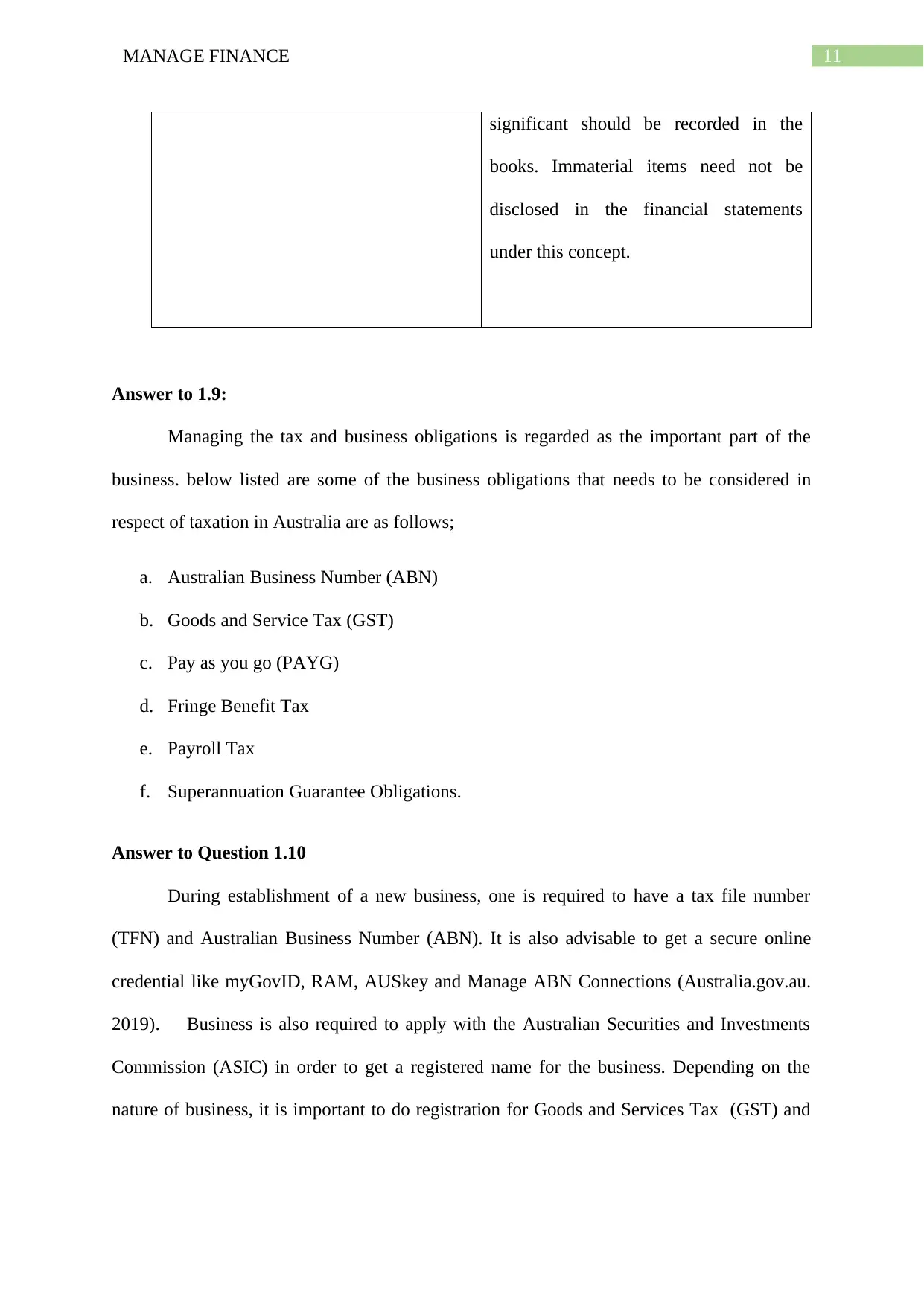
11MANAGE FINANCE
significant should be recorded in the
books. Immaterial items need not be
disclosed in the financial statements
under this concept.
Answer to 1.9:
Managing the tax and business obligations is regarded as the important part of the
business. below listed are some of the business obligations that needs to be considered in
respect of taxation in Australia are as follows;
a. Australian Business Number (ABN)
b. Goods and Service Tax (GST)
c. Pay as you go (PAYG)
d. Fringe Benefit Tax
e. Payroll Tax
f. Superannuation Guarantee Obligations.
Answer to Question 1.10
During establishment of a new business, one is required to have a tax file number
(TFN) and Australian Business Number (ABN). It is also advisable to get a secure online
credential like myGovID, RAM, AUSkey and Manage ABN Connections (Australia.gov.au.
2019). Business is also required to apply with the Australian Securities and Investments
Commission (ASIC) in order to get a registered name for the business. Depending on the
nature of business, it is important to do registration for Goods and Services Tax (GST) and
significant should be recorded in the
books. Immaterial items need not be
disclosed in the financial statements
under this concept.
Answer to 1.9:
Managing the tax and business obligations is regarded as the important part of the
business. below listed are some of the business obligations that needs to be considered in
respect of taxation in Australia are as follows;
a. Australian Business Number (ABN)
b. Goods and Service Tax (GST)
c. Pay as you go (PAYG)
d. Fringe Benefit Tax
e. Payroll Tax
f. Superannuation Guarantee Obligations.
Answer to Question 1.10
During establishment of a new business, one is required to have a tax file number
(TFN) and Australian Business Number (ABN). It is also advisable to get a secure online
credential like myGovID, RAM, AUSkey and Manage ABN Connections (Australia.gov.au.
2019). Business is also required to apply with the Australian Securities and Investments
Commission (ASIC) in order to get a registered name for the business. Depending on the
nature of business, it is important to do registration for Goods and Services Tax (GST) and
⊘ This is a preview!⊘
Do you want full access?
Subscribe today to unlock all pages.

Trusted by 1+ million students worldwide
1 out of 32
Related Documents
Your All-in-One AI-Powered Toolkit for Academic Success.
+13062052269
info@desklib.com
Available 24*7 on WhatsApp / Email
![[object Object]](/_next/static/media/star-bottom.7253800d.svg)
Unlock your academic potential
Copyright © 2020–2025 A2Z Services. All Rights Reserved. Developed and managed by ZUCOL.





